Rossella Biscotti (Molfetta, 1978) is among the most interesting contemporary European artists. With her work, Rossella Biscotti investigates archival objects and materials to bring out their history (even the most uncomfortable, or the forgotten) and to emphasize the relationships between artistic practice and historical context, through work that starts from individual or collective memory and makes use of meticulous research on period materials. With her works, Rossella Biscotti (who currently lives and works in Amsterdam) has participated in several important international exhibitions (Venice Biennale, Documenta, Manifesta and others) and has anticipated some of the themes that later became the subject of strong media debate in Italy and beyond. We interviewed her to let her tell us about her latest projects and to go over some important stages of her career. Theinterview is edited by Federico Giannini, editor in chief of Finestre sull’Arte.
 |
| Scarlett Biscotti. Ph. Credit Luis Filipe do Rosario. Courtesy Wilfried Lentz, Rotterdam and Mor Charpentier, Paris |
FG. I would like to begin this interview with some breaking news: the Graham Foundation awarded you, a few days ago, a grant for your project The City, which began in 2013. The interesting aspect of this work is its willingness to find reflections between past societies and contemporary society: after all, even the work of archaeologists compares two different types of organization at the same time. What will happen now to the project with this new chapter?
RB. The City was born a while ago: it is a complex project that arose from an invitation that was extended to me by Turkish curator Övül Durmu?o?lu and U.S. curator Mari Spirito, the latter director of Protocinema in Istanbul: their wish was to take two contemporary artists, namely myself and Lebanese filmmaker Akram Zaatari, to visit a museum of archaeology (the Museum of Anatolian Civilizations in Ankara), to begin from there a kind of journey within archaeology. A journey that we questioned from the very first visit by deciding to go and see archaeology in its making, and not simply in its musealization. So we began a tour together, four of us, visiting several active sites, and in the course of these visits we discussed at length, even complex topics (for example, how archaeology is, in a sense, destruction of the landscape, the ways in which archaeologists dialogue with local communities, what a research excavation and an excavation aimed at extracting from the ground artifacts that then end up in a museum mean: topics that the work addresses). At the last site we went to, Çatalhöyük, in Anatolia, I realized that this was a place that could unite interests I had on several fronts: thus, I began a conversation with British archaeologist Ian Hodder, head of the Çatalhöyük Research Project and a pioneer of post-processual archaeology, a movement that took archaeology to a different dimension (a community dimension, a processual dimension, of research), bringing laboratories to the site) regarding what had struck me about this site, namely the fact that Çatalhöyük is a large, stratified Neolithic settlement (ranging from 9.000 to 6,500 B.C.), and the fact that the group of archaeologists working on the site adopted a very non-hierarchical form of organization, combining work and ways of life. The research team was quite large, since, in the summer, it grew to as many as 150 people, ranging from the student to the Oxford super specialist. Every day they were digging and producing knowledge (part of the structural revolution of the site was in fact to have built the on-location specialist labs in such a way as to process data through an intersection of knowledge and experience). I was part of the team for four years, making notes and filming at the site until 2016, when I went to Çatalhöyük with a specific team in order to make a film: however, due to the attempted coup in Turkey, the site at that time decided to close temporarily and we could not finish the work. I made an initial work, a very complex video installation (it is five projections, sixty minutes, eight audio channels) using both my own footage/notes of the site in full activity recorded in the early years and professional footage of the site at the time of closure overlaying the archaeological excavation, the community, the political, the contemporary. And now, through the Graham Foundation, what I want to do is to turn this installation, which is primarily experienced at the museum, into a unique documentary, and that can then be broadcast on different channels (from television to film).
I like to think of her as a kind of archaeologist of memory, able to dig into the recent past of Italy and beyond, to resurface testimonies whose memory is in danger of being lost. And here I am reminded of important works in her career, such as The Trial or The Anarchists Do Not Archive. In fact, I would say it is interesting to start from the title of your work for the 2010 Carrara Biennial, which itself takes the title of a catalog of anarchist manifestos, to see that in reality we are often inclined to archive large parts of our history, especially recent history, at the risk of forgetting it. In your opinion then, what should be in this sense the function of art in regard to history or memory?
I would like to refer back to The City for a moment to point out that it is the first work in which I was directly confronted with archaeology, because, in fact, I have always worked primarily with the archaeology of the modern, and in particular with the twentieth century. If we are talking about the position of the artist towards history and memory obviously we are talking about two very different situations, I am much closer to memory also because I like to investigate on various fronts, both through archival materials and through interviews (I am very interested in subjective memory, how things have been handed down from subject to subject, how they reach the contemporary). So it is an extended memory, and what I am mainly interested in is a memory made by individuals. A lot of my work, however, confronts history by intervening in what we can call “the system,” that is, society. The art, in my case, tries to give the dimension of this confrontation between the memory of the individual and the formalized history, which has already been “edited,” or has already undergone that “editing of information” that I sometimes talk about with my works.
 |
| Rossella Biscotti, The City (2013-; video installation 5 video channels, 8 audio channels). Installation view, Kunsthaus Baselland (2018). Ph. Credit Serge Hasenböhler. Courtesy Wilfried Lentz, Rotterdam and Mor Charpentier, Paris. |
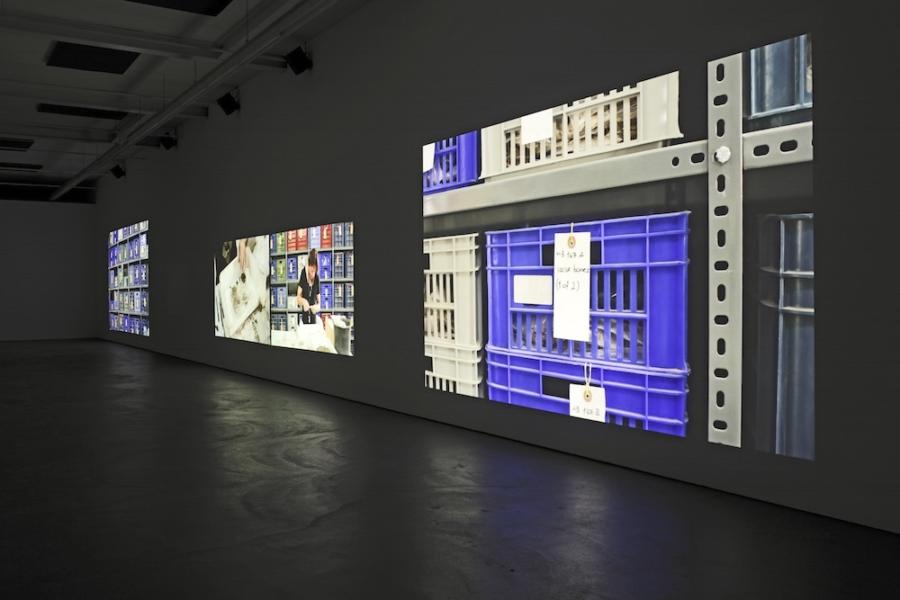 |
| Rossella Biscotti, The City (2013-; video installation 5 video channels, 8 audio channels). Installation view, Kunsthaus Baselland (2018). Ph. Credit Serge Hasenböhler. Courtesy Wilfried Lentz, Rotterdam and Mor Charpentier, Paris. |
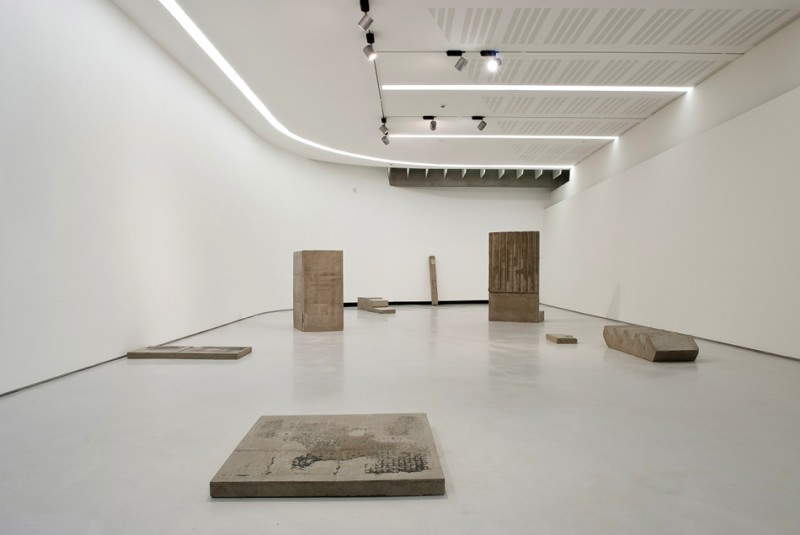 |
| Rossella Biscotti, The Process (2010-; sound installation, concrete casts, various sizes). Installation view, Premio Italia Arte Contemporanea, MAXXI, Rome. Ph. Credit Sebastiano Luciano. Courtesy Wilfried Lentz, Rotterdam and Mor Charpentier, Paris. |
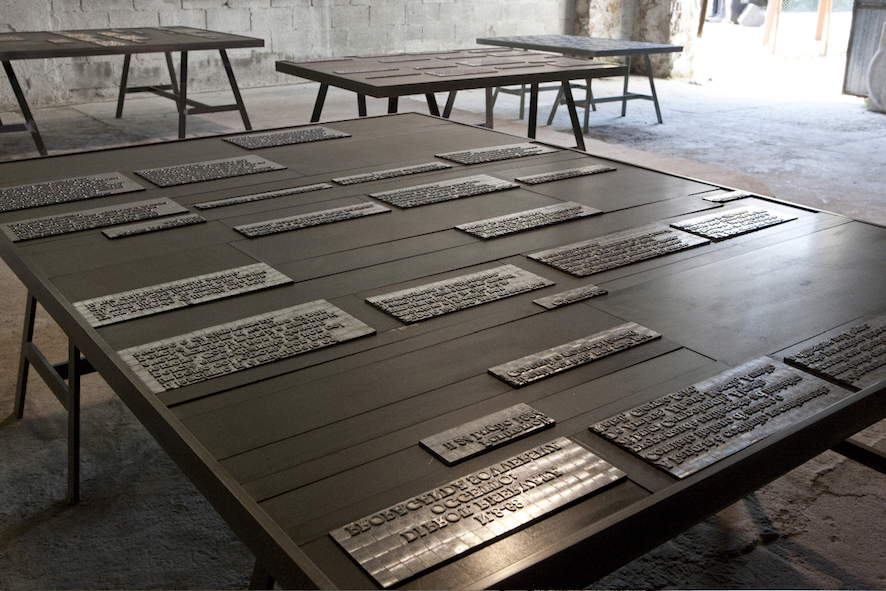 |
| Rossella Biscotti, Anarchists Don’t Archive (2010; metal, mobile lead characters). Installation view, 14th International Sculpture Biennale, Carrara, 2010. Ph. Credit Gennaro Navarra. Courtesy Wilfried Lentz, Rotterdam and Mor Charpentier, Paris. |
When I think of individual memory, I am reminded of your work A shirt, blue pants, blue jeans, a towel, in which you addressed not only the history of people, but also the history of place, simultaneously. Here: this might be a good example of that confrontation between individual memory and history that we just talked about. So it would be curious to understand how this confrontation takes place within the work.
We are talking about a very particular work because it comes, in turn, from a very particular commission, which was given to me by the church of Sankt Peter in Cologne, a Jesuit church where Rubens’ last altarpiece, the Crucifixion of St. Peter, is located. But this place is also linked to the great painter by the fact that his father was born near there, so it was a church frequented by Rubens (moreover, Rubens’ father’s tomb is also said to be one of those under the floor). It is a church that, like all of Cologne, was bombed and partly destroyed during World War II. The work had been commissioned by the church itself, by the church community, which had presented other contemporary art exhibitions but had never been actively involved in a project. The work, in this case, started from the memory of the city and the fact that Cologne was heavily bombed, and I wanted to imagine how this modern city was built on the rubble of a war. Starting with the Sankt Peter church floor itself: it’s polished concrete, very minimal, beautiful, but it also contains graves and rubble from World War II. And it became the setting for the work: in order to make it, I thought of involving the whole church community, whom I asked to donate clothes (though not as it is normally done, that is, when people donate clothes that they would otherwise throw away: I asked them to donate clothes that had meaning for their owners, clothes that people wanted to be included in the work by becoming part of it and, consequently, becoming the memory of those who had donated them). Some donations came with a message. I had many donations, some of them poignant, for example, clothes of people who had died, others very nice, such as leopard underwear and striped and mismatched socks, and many donations from the priest himself, who donated clothes and sacred vestments. I then incorporated the donations inside sculptures, some spheres and some polished concrete blocks, which were later displayed inside the church in an installation that spanned the entire space and seemed to emerge from the space itself. The largest sculpture consisted only of bed sheets and pillowcases: we made it directly in the church, and it was in direct relation to Rubens’ painting and thus to his Crucifixion of St. Peter. And there is not only a visual reference, in the sense that the form of the work recalled that of the body of St. Peter crucified: we also have to imagine the very strong materiality of these fabric and concrete sculptures, an element that in turn relates to the materiality and colors of Rubens’ painting.
Speaking of the memory of the city: one of the most interesting results of his research in the archives was the work The Heads in the Object, five monumental sculptures depicting the heads of Mussolini and Victor Emmanuel III that ended up in a warehouse in Rome, which were given new life in the sense that they became works of art charged with new meanings. A work that therefore anticipates by several years the debate that is developing about monuments these days, in regard to which you moreover also seem to be rather participatory on social media. I would therefore ask you what is the idea of “monument” conveyed by this work of yours that inevitably addresses the problem of the persistence of monuments.
Theheads in question was born while I was doing research in Rome (which then extended to Tuscany) on Fascist buildings under renovation: so I was in Rome, at the EUR Palace of Offices, which was under renovation at the time, to do some research on what was being preserved and what was instead being removed, even at the level of symbols. There, precisely because I was working inside the building and knew the people who were working on this renovation, I was asked if I had seen those big heads (or those “big heads,” as I was told) that were in the storage rooms. When I went into the storage room I saw them that they were swamped with dust and junk: it was 2006, and when in 2009 the Nomas Foundation asked me to do an exhibition I thought of using the information I had gathered three years earlier (I stress that it happens to me very often that I let a few years pass from a research and then come back to that same topic with a work), and at that time the idea was to transport the heads from the storage room to the exhibition, put them on display two days, and then have them returned to storage. This oh-so-simple operation (we even decided to display the sculptures without dusting them or removing them from their pallets) actually provoked a lot of discussion: even, at the time we sat down at the table and decided to carry it out, there was even a discussion about whether this operation could result in attacks from fascists, or attacks from the left, and also whether it would attract (which then promptly occurred) nostalgic people who would take pictures with the heads. This two-day event, along with the discussion that emerged (which then made its way back into the exhibition with a lecture I gave at the conclusion), intervened in a debate that was still brewing at the time: what to do with these works? What to keep? What to hide? What to destroy? At that time Rome was deciding to show a lot of things, it was the period when the great obelisk of Mussolini at the Foro Italico was being restored, and the exhibition was a very interesting opportunity for in-depth study: because we did not expect it but a lot of people were like unburdened, many wanted to learn more about the history of these works (and the past they represent) and the reaction even of physical relationship with the object + was varied: some took photos, some touched them, some analyzed them minutely (we discovered that a defaced statue hid a hammer and sickle drawn on its cheek and then covered with a layer of patina), and some simply wanted to walk around it, physically elevating themselves to a higher level of height than the statue, unknowingly taking on a different dimension than that of the monument. Then, when I was asked to do an exhibition in 2015, at the Museion in Bolzano, taking up these sculptures, I thought it was impossible: I felt that the passage of these works to a museum could overturn the meaning of the operation that had been done at Nomas, in the sense that that ephemeral operation had highlighted a whole series of contradictions, which are then the same ones that are emerging now with the Black Lives Matter movement and with the removal of the monuments that we are witnessing in these weeks. I couldn’t re-musealize the heads. So I decided to reproduce them through colored silicone casts (we used a silicone that is used to make casts of objects sold as souvenirs), we used a technique that would allow easy reproducibility, and we convinced the superintendency to give us permission to make the casts. All of this was because I wanted the topic of discussion to be changed and the debate to be about the possibility of reproducing the past, in line with what was happening in 2015, when there was talk of returns (in a different form) of fascism. This is also why we decided to give a kind of pop appearance to the sculptures and to create an illusory effect (the hollow image of the cast, if you moved away from it, gave the impression of becoming convex, thus three-dimensional again). I believe that when it comes to history, but also when it comes to monuments, one cannot be ignorant; the point is to know the history and understand how it relates to the contemporary. The same statue, when invested with projections or accompanied by a sign (for example, when the image of John Lewis, a civil rights pioneer, was projected on the statue of General Robert E. Lee in Richmond, Virginia, U.S., on July 19, 2020, during the Black Lives Matter movement protests) can completely change its meaning and acquire another force, show the layering of history, or see its initial meaning completely reversed.
 |
| Rossella Biscotti, A shirt, blue pants, blue jeans, a towel (2018; 24 concrete sculptures, textiles, dimensions variable). Installation view, Sankt Peter Church, Cologne (208). Ph. Credit Christopher Clem Franken. Courtesy Wilfried Lentz, Rotterdam and Mor Charpentier, Paris. |
 |
| Rossella Biscotti, A shirt, blue pants, blue jeans, a towel (2018; 24 sculptures, textiles, dimensions variable). Installation view, Sankt Peter Church, Cologne (208). Ph. Credit Christopher Clem Franken. Courtesy Wilfried Lentz, Rotterdam and Mor Charpentier, Paris. |
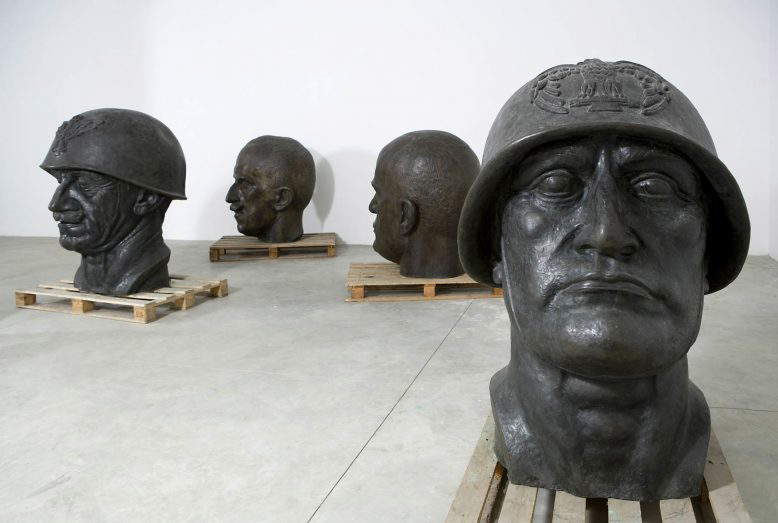 |
| Rossella Biscotti, The Heads in Object (2009). Installation view, Nomas Foundation, Rome (2009). Ph. Credit Ela Bialkowska. Courtesy Wilfried Lentz, Rotterdam and Mor Charpentier, Paris. |
 |
| Rossella Biscotti, The Heads in Object (2014; 5 silicone and resin sculptures, various sizes). Installation view The Future can only be for Ghosts, Museion, Bolzano (2014). Ph. Credit Luca Meneghel. Courtesy Wilfried Lentz, Rotterdam and Mor Charpentier, Paris. |
 |
| Rossella Biscotti, Cinematography is the strongest weapon (2003-2007). Interlude inside a cinema , Strombeek, Belgium (2015). Courtesy Wilfried Lentz, Rotterdam and Mor Charpentier, Paris |
It is a situation that is perhaps more evident and less misunderstandable when we see a head of Mussolini or Victor Emmanuel, but the barriers that divide us from the past could become much more labile when we are confronted with a His work such as Cinematography is the strongest weapon, which takes up Mussolini’s famous phrase that, however, without connotation, can run the risk of becoming ambiguous. Is this a possibility that needs to be defused?
Most of my works are ambiguous, I am interested in maintaining the different levels of meaning, and I am interested in the viewer asking a question: for me the question that starts from the viewer’s point of view is fundamental, I am not interested in giving ready answers, I am interested in provoking questions, discussions, however in a complex way. Cinematography is the strongest weapon dates back to 2003, as a mural painting at the Olivetti Foundation in Rome, then taken up later and projected redone as an “interlude” inserted between various screenings in the cinema. In this case it is the lettering that is reminiscent of fascism: I make a point of the fact that maybe the viewer does not recognize the quote, but as Italians we are used to that kind of graphic art, which we know is fascist, we recognize it by its very strong, unmistakable aesthetic. It is a work that works on ambiguity also because it goes back to a historical period in which Berlusconi used television in a propagandistic way and this use of it aroused strong debates: here, for me this ambiguity is important because it opens up different dimensions, which do not only concern the historical period to which a phrase goes back (in this case to the Fascist Twenty Years), but that it can also speak about very current topics.
You have used this process to talk about another very current topic, that of migration, in this case with the work Clara, which examines the topic from the point of view of animals and in particular from that of Clara, one of the most famous rhinos in history, which also ended up in several works of art from the eighteenth century. What then are the continuities with the present that the story of this animal suggested to you?
For me, Clara’s story is very interesting: it is the story of a rhinoceros but it could also be the story of a human. I think the similarities have to be sought in the experience of exploitation of a living thing that is captured and shipped to Europe for its exoticism, then used as a freak show, became the object of business of one of the captains of the Dutch East India Company, painted by artists, so much so that it became very well known and very famous, but always remaining exploited. The work, on a material level, takes the form of a series of bricks made by one of the last factories in the Netherlands producing bricks by ancient processes (with fire and clay from the rivers in the area), because bricks were used to balance ships traveling to the East. And Clara, in the work, is depicted through various translations of her being (her weight, her economic value, even what was thought to be her vice: that is, she was said to have a tobacco habit because during the voyage the sailors smoked on her), without any mention of her as an animal or living being. Later I did another exhibition starting with Clara but changing the subject, and the only thing there was about her within this exhibition, which was mainly about exploitation (in that case of plants and women), was the smell, because it was said that in order to keep her skin moist, Clara was sprinkled with fish oil, and a reproduction of the manifest of the cargo ship she traveled with (I also found out that Clara traveled on a ship full of textiles to get to Europe). I also anticipate that Clara will be the subject of an exhibition at the Rijksmuseum next year: the work will be included within an exhibition that will bring all the images of Clara inside the Amsterdam museum.
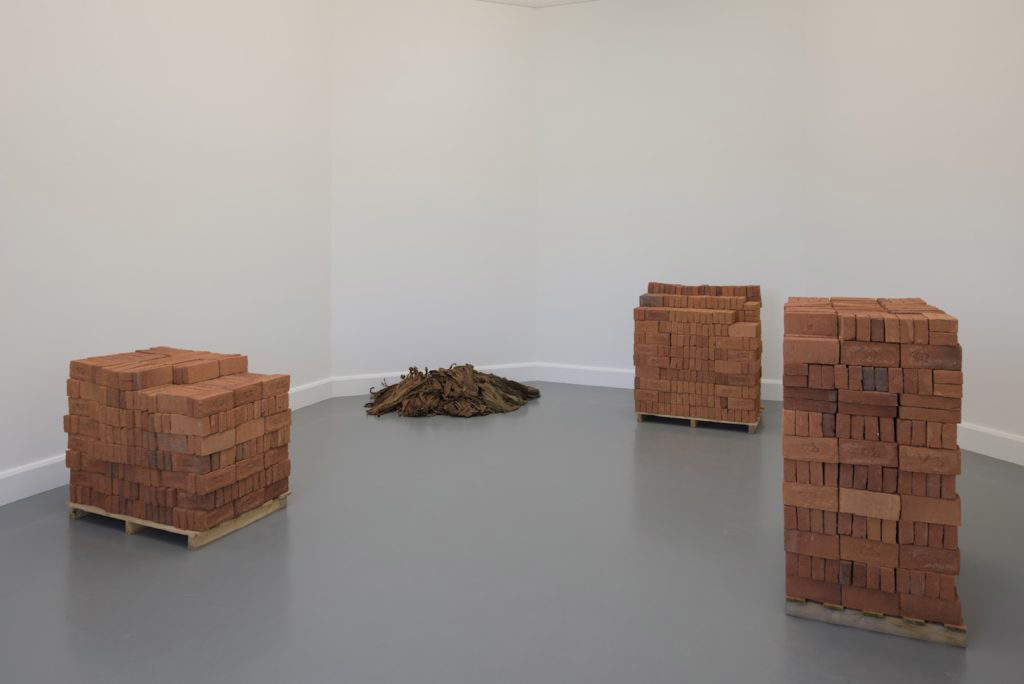 |
| Rossella Biscotti, Clara (2016; 3 tons of handmade Dutch bricks, 2.7 kg of tobacco, wall vinyl). Installation view, Van Abbemuseum, Eindhoven (2016). Ph. Credit Peter Cox. Courtesy Wilfried Lentz, Rotterdam and Mor Charpentier, Paris. |
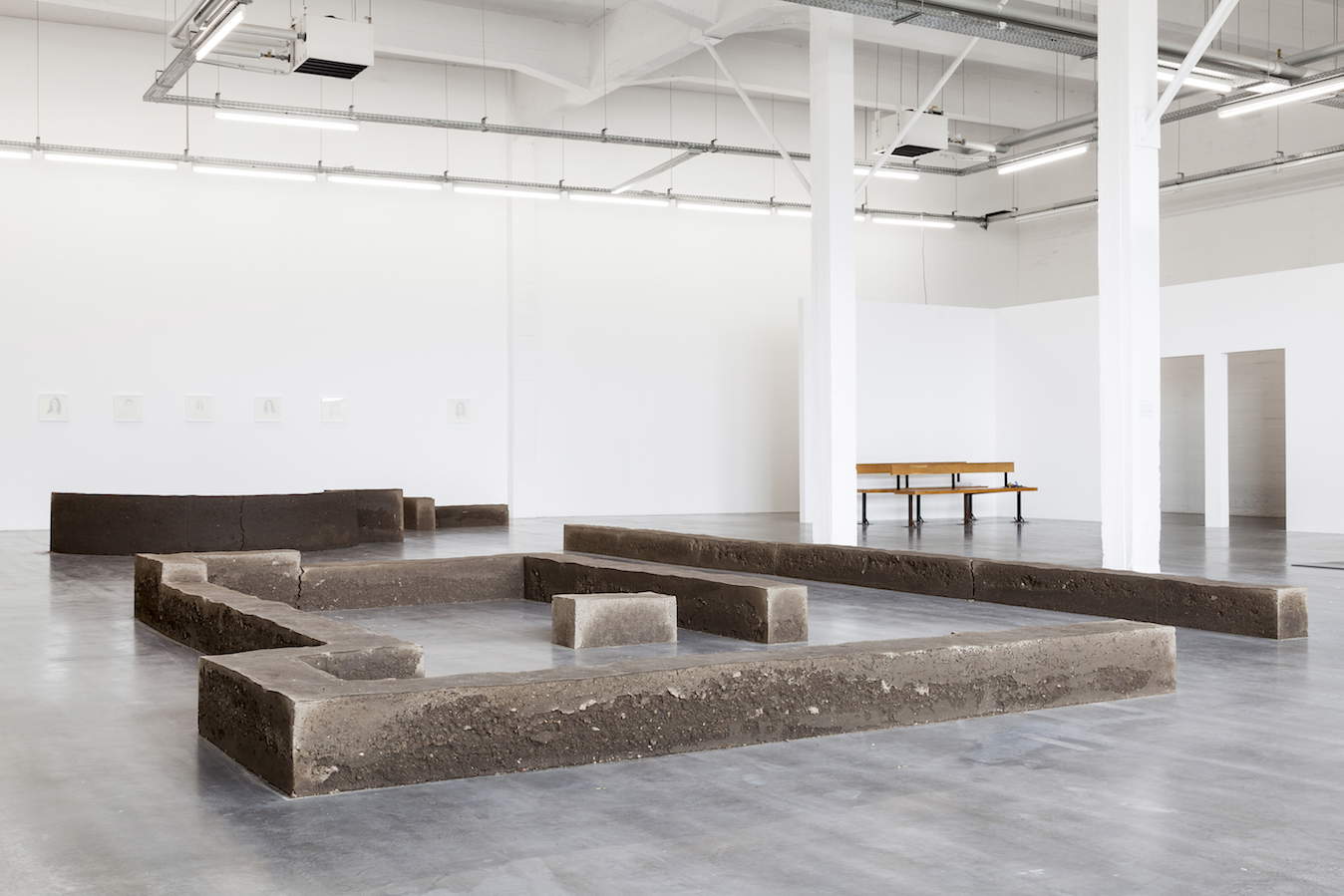 |
| Rossella Biscotti, I dreamt that you changed into a cat.... cat... ha ha ha (2013; compost sculptures of varying sizes, 60-minute sound installation, 12 framed drawings, 34 x 34 cm each). Installation view, WIELS, Brussels (2014). Ph. Credit Sven Laurent. Courtesy Wilfried Lentz, Rotterdam and Mor Charpentier, Paris. |
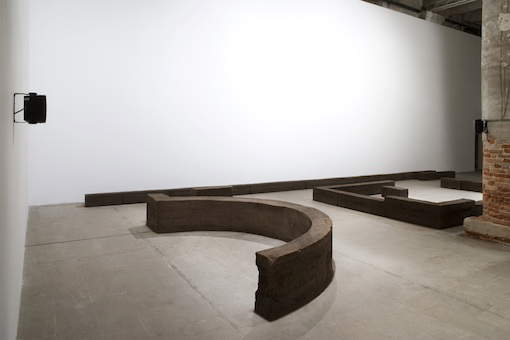 |
| Rossella Biscotti, I dreamt that you changed into a cat.... cat... ha ha (2013; compost sculptures of varying sizes, 60-minute sound installation, 12 framed drawings, 34 x 34 cm each). Installation view, Venice Biennale 2013. Ph. Credit Ilaria Zennaro. Courtesy Wilfried Lentz, Rotterdam and Mor Charpentier, Paris. |
To conclude, I would like to return to the 2013 Biennale, which dealt with the dimension of dreaming and remains one of Your most well-known experiences. Dreaming is an important activity for an artist-I think we partly, implicitly, get that from our conversation as well. In your opinion, are museums and art institutions today still able to do that?
That would be nice! In my experience, the bigger the institutions are, the more they become machines, so there is so much difficulty in being streamlined, able to accommodate inspirations, dreams, projects that are or seem impossible or difficult to realize. Again in my personal experience, what I try to do with my working method is to aggregate institutions, then work a little bit at a time and gradually bring together institutions that would otherwise never be together (perhaps because they come from different contexts), with the aim of making something big, and clearly this means time, it means that the work maybe has a completely different gestation, but certainly it is also a methodology that allows for a lot of freedom, and this idea of freedom connects, in my experience, to the idea of dreams. This year, for example, I went back to Carrara to make a work from the 2010 International Sculpture Biennial, where I had won the Michelangelo Prize, which consisted of a large block of marble that I never thought of making use of, but at a certain point I changed my mind and thought of making it part of a project called The Journey, of making it travel in the Mediterranean and eventually releasing it in international waters. It is a project that I had presented with a script at the Quadriennale in Rome in 2016, then I had re-presented it at the Van Abbemuseum in Eindhoven producing a series of maps and analyzing the social, geological and political stratification of the of places in the Mediterranean in which as a place that will host this block, in a journey-performance that brings together the Kunstenfestival in Brussels, Dream City which is a dance and performance festival in Tunis, Blitz which is a nonprofit space in Malta, and other international institutions to be confirmed. So through all these institutions, I will be able to realize a project that would otherwise be unfeasible. A dream, in essence.
Warning: the translation into English of the original Italian article was created using automatic tools. We undertake to review all articles, but we do not guarantee the total absence of inaccuracies in the translation due to the program. You can find the original by clicking on the ITA button. If you find any mistake,please contact us.